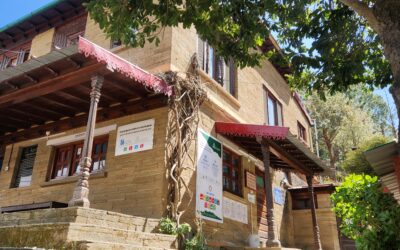Being part of an education innovation which aims at changing attitude through change in content delivery.
At Aavishkaar I see the social sector expanding to introduce an intellectual attitude as one of the human rights to protest for. I go to classrooms every week to facilitate a curious mind in the forty five children I meet, through fraction kits and linking cubes and games where positive and negative integers are way different from plus and minus numbers.
In my first session at Rajpur, the biggest struggle was managing the classroom and an even bigger struggle was managing the content. I spent one week trying to figure out how to take Integers to the classroom. I focused on the activities in the next session at Rajpur which led me to develop a game for Integers which combined play with studies. We drove cars on integer roads and it became a hit in my classrooms!

Spending considerable time with the content helped me restrict Integers in the classroom to only two sessions. October onwards, the pace of the work increased manifold with several other responsibilities besides the classroom engagement and facilitation, which made me reset work priorities. Today, I spend one hour to map the content and another half an hour to decide classroom management techniques. My own developing concept clarity with fractions caused me to do several retakes of the same topics.
The month long gap in between, which I spent in Bihar working with the Nari Gunjan girls, helped me realign priorities in such a way that I could focus more on the students and their growth. I worked on building strong relationships with the students October onwards. This involved learning their names, their likes and dislikes, handing out interactive notebooks to each one of them and giving stickers as daily rewards. The facilitation has developed over the past five months in a tremendous way. I started with making a norms poster for my classroom. In the next few classes I had to work on the time-management and student-relationships. It was only in November that the value of content and asking the right questions in the classroom became my priority. I now understood what the Aavishkaar method was and how I could align my class to focus on building curiosity, creativity and critical thinking.

Sahil was one of the most distractible students of one of my classroom. His enthusiasm and energy pushed him to channelise his attention in ways that usually became a distraction for the classroom. However, with the use of hands, head and heart in the class his energy has been through these three different outlets. In his notebook. To assess the work of the students, I had introduced interactive notebooks which helped in exciting the students. Interactive notebooks meant that I could put in puzzles in it and so could they, it wasn’t the students work which I would be checking daily, but a combined effort put from both the learner and the facilitator.
Last month Sahil expressed his side through a move which made me realise that he was feeling the ownership of his learning. He decorated his notebook with stickers he had collected and felt like it was part of his life and had that space in the notebook.

From classroom observations it became even more surprising that now Sahil can use his critical thinking skills to find answers to questions which are beyond their textbooks. For example, during the second month in the third class for fractions (September 2018), Sahil was not even able to call ½ as half – he would often call it 1 point 2 or 1 2 as separate numbers. In the eighth session, I could see the glitch in his understanding and finally was able to resolve it by pushing him deeper into the problem. Sahil had a pattern of calling all fractions halves, so that day I called him to do it on the board and when he wrote ½ for 1/3rd – i asked him what 2 in the ½ signified and he suddenly remembered and understood his mistake. 2 would mean the number of parts in a fraction. So he corrected the fraction to 1/3 and automatically said the correct name – one-third.
A researcher’s journey for him started in October during a game on mixed fractions – Sahil saw 1/8th as half of 1/4th! This discovery could have been short-lived. However, as recent as in December, he was able to justify why 2/5ths and 1/10th when added make a half by explaining how 2 times 5 is 10 and so 2 times 1/10th would be 1/5th. The concept that ‘if half of 10 is 5, in fractions half of 1/5th will be 1/10th’ has been discovered and developed by himself which shows how his analytical thinking skills have been triggered.
His math teacher said during of the meetings, “Sahil has improved in classroom participation. Not only we see him talk more in your class, he is also more active in ours. Sahil has also improved in his marks this time (scores a 9 out of 20 as opposed to 1 or 2 earlier).”
I realised how important it was for a child to be made to question and analyse. Such skills are delivered neither by their teachers nor parents, unfortunaltely. Our policy makers, academics, scientists – all have to struggle to be able to innovate policies or ideas that are indigenous and not replications. I wasn’t saved from this loop either, not even here at Aavishkaar. After taking three sessions of the same topic in the same classroom with the same students, I had wondered
Where was I going wrong?
Were my activities not good enough?
Was I not getting enough time to make the students practice?
Perhaps, I was just doing the same thing that the Math textbooks of these kids were doing to them. I was surely developing a new method to do comparison of fractions, but I had missed out on addressing the ‘WHY’. I had become so used to my students understanding everything in class that the annoyance of them not being able to understand made me doubt everything except my own facilitation.




0 Comments